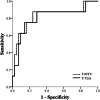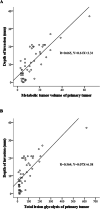Analysis of PET parameters as prognosticators of survival and tumor extent in Oropharyngeal Cancer treated with surgery and postoperative radiotherapy
- PMID: 33765966
- PMCID: PMC7992344
- DOI: 10.1186/s12885-021-08035-9
Analysis of PET parameters as prognosticators of survival and tumor extent in Oropharyngeal Cancer treated with surgery and postoperative radiotherapy
Abstract
Background: Positron-emission tomography (PET) is widely used to detect malignancies, but consensus on its prognostic value in oropharyngeal cancer has not been established. The purpose of this study was to analyze the PET parameters associated with tumor extent and survival in resectable oropharyngeal cancer.
Methods: The PET parameters in oropharyngeal cancer patients with regional node metastasis who underwent surgery and postoperative radiotherapy between January 2005 and January 2019 were analyzed. We calculated the SUVmax, tumor-to-liver ratio (TLR), metabolic tumor volume (MTV, volume over SUV 2.5), and total lesion glycolysis (TLG, MTV x mean SUV) of the primary lesion and metastatic nodes. Histologic findings, patient survival, and recurrence were reviewed in the medical records.
Results: Fifty patients were included, and the PET parameters were extracted for 50 primary lesions and 104 nodal lesions. In the survival analysis, MTV and TLG of the primary lesions showed significant differences in overall survival (OS) and recurrence-free survival (RFS). In the multiple regression analysis, TLG of the primary lesion was associated with the depth of invasion (DOI). MTV of the nodes was a significant factor affecting extranodal extension (ENE).
Conclusions: PET parameters could be related with OS, RFS, DOI of the primary tumor, and ENE. PET would be expected to be a useful diagnostic tool as a prognosticator of survival and pathologic findings in oropharyngeal cancer.
Keywords: Depth of invasion; Extranodal extension; Oropharyngeal cancer; PET; SUVmax.
Conflict of interest statement
The authors declare that they have no conflict of interest.
Figures




References
-
- Strauss LG, Conti PS. The applications of PET in clinical oncology. J Nucl Med. 1991;32(4):623–648. - PubMed
-
- Larson SM, Erdi Y, Akhurst T, Mazumdar M, Macapinlac HA, Finn RD, Casilla C, Fazzari M, Srivastava N, Yeung HW, Humm JL, Guillem J, Downey R, Karpeh M, Cohen AE, Ginsberg R. Tumor treatment response based on visual and quantitative changes in global tumor glycolysis using PET-FDG imaging. The visual response score and the change in Total lesion glycolysis. Clin Positron Imaging. 1999;2(3):159–171. doi: 10.1016/S1095-0397(99)00016-3. - DOI - PubMed
MeSH terms
Substances
LinkOut - more resources
Full Text Sources
Other Literature Sources

